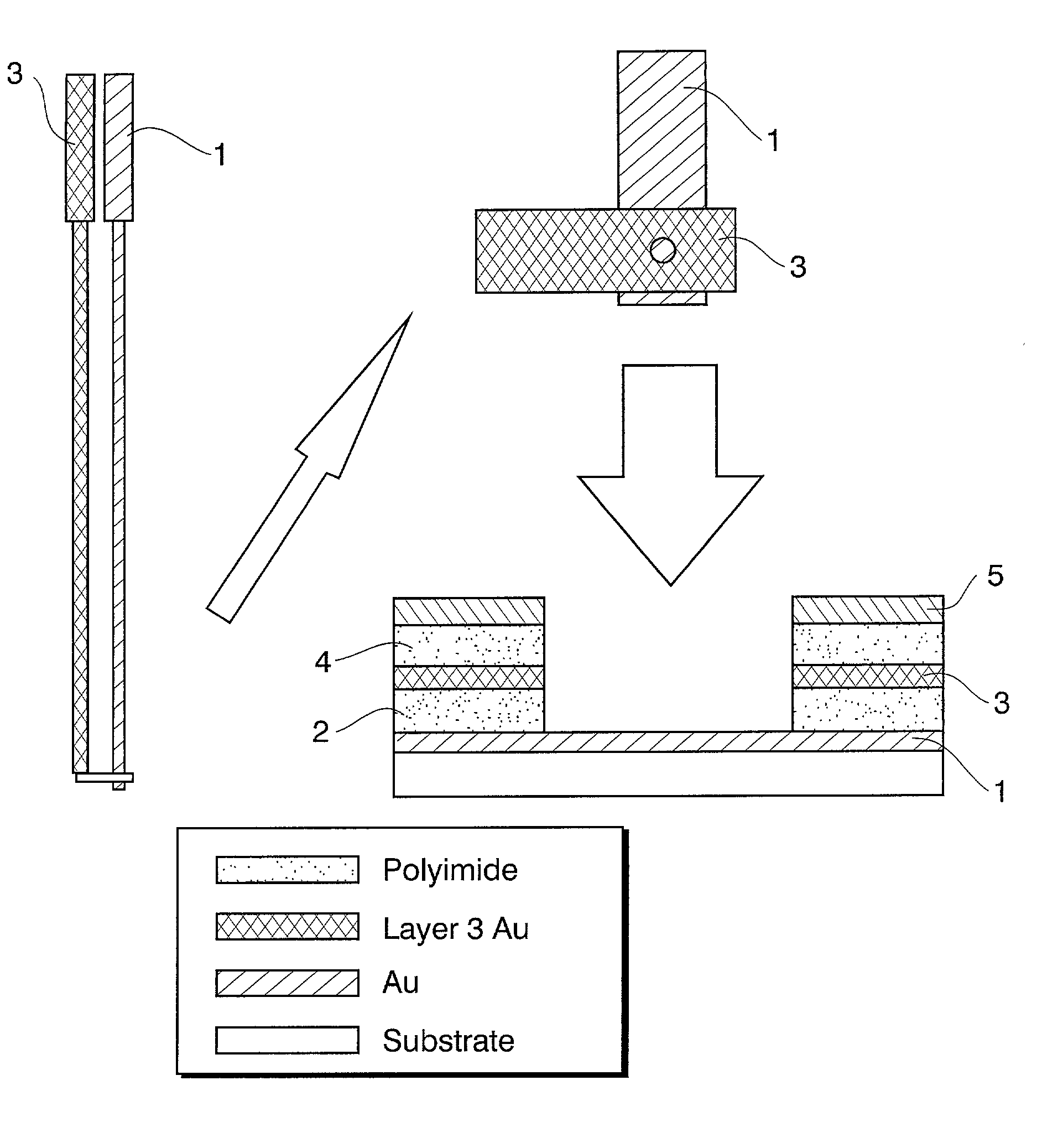Microfabricated recessed disk microelectrodes: characterization in static and convective solutions
a microelectrode and recessed disk technology, applied in the field of microelectrodes, can solve the problems of not being very reproducible, not validating the conclusions based on those studies, and devices with fast scan rates, and achieve the effect of increasing the three-dimensional functionality of the devi
- Summary
- Abstract
- Description
- Claims
- Application Information
AI Technical Summary
Benefits of technology
Problems solved by technology
Method used
Image
Examples
example 1
Materials
[0067]All chemicals were reagent grade and used as received. Aqueous solutions were prepared with high purity deonized water (Mille-Q, model RG). A gold coin (Credit Suisse, 99.99%) and chromium plated tungsten rod (R.D. Mathis) served as sources for thermal evaporation. Silicon wafers (5″, (100) were obtained from Silicon Quest International (Santa Clara, Calif.). Potassium nitrate, sulfuric acid, hydrochloric acid, nitric acid and 30% hydrogen peroxide were purchased from Fisher Scientific. Hexaamine-ruthenium (III) chloride was obtained from Alderich Chemical Co. Positive photoresist (AZ330RS) and photoresist developer (AZ00K) were purchased from Hoechst-Celanese. Polymide (Pyralin PI-2721, DuPont) was purchased from DuPont. A gold 10 μm diameter PDM (BioAnalytical Systems) BAS was used as the control.
Electrochemical Measurements
[0068]A BAS-100B potentiostat and PA-1 preamplifier controlled with BAS-100W electrochemical software were used to perform cyclic voltammetry (C...
example 2
[0089]All chemicals were reagent grade and used as received. Aqueous solutions were prepared with high purity deionized water (Milli-Q). A gold coin (Credit Suisse, 99.99%) and chromium plated tungsten rod (R.O. Mathis) served as sources for thermal evaporation. Silicon wafers (5″, (100)) were donated by the High Density Electronics Center at the University of Arkansas. Potassium nitrate, sulfuric acid, and 30% hydrogen peroxide were obtained from Fisher Scientific. Hexaamine ruthenium(III) chloride was purchased from Aldrich Chemical Co. Positive photoresist (AZ4330RS) and photoresist developer (AZ400K) were obtained from Hoechst-Celanese. Photodefineable polyimide (Pyralin PI-2721) was purchased from DuPont.
Array Fabrication
[0090]The fabrication of microcavity electrode arrays was accomplished through the use of photolithographic techniques developed for integrated circuit technology. A simplified version of this fabrication has been reported previously. The cavity reported here c...
example 3
[0105]All chemicals were reagent grade and used as received. Aqueous solutions were prepared with high purity deionized water (Milli-Q, model RG). A gold coin (Credit Suisse, 99.99%) and a chromium plated tungsten rod (R.D. Mathis) served as sources for thermal evaporation. Silicon wafers (5″, (100)) were donated by the High Density Electronics Packaging Facility, University of Arkansas. Potassium nitrate, sulfuric acid, hydrochloric acid, silver nitrate, potassium iodide, sodium thiosulfate, nitric acid and 30% hydrogen peroxide were purchased from Fisher Scientific. Hexaamine ruthenium(lll) chloride and hydroquinone were obtained from Aldrich Chemical Co. Positive photoresist (AZ4330RS) and photoresist developer (AZ400K) were purchased from Hoechst-Celanese. Polyimide (Pyralin PI-2721, DuPont) was purchased from DuPont.
Cavity Microelectrode Construction.
[0106]The fabrication of the cavity electrode system (CES) has been described previously. In brief, the CES is made by depositing...
PUM
| Property | Measurement | Unit |
|---|---|---|
| diameters | aaaaa | aaaaa |
| diameters | aaaaa | aaaaa |
| volumes | aaaaa | aaaaa |
Abstract
Description
Claims
Application Information
 Login to View More
Login to View More - R&D
- Intellectual Property
- Life Sciences
- Materials
- Tech Scout
- Unparalleled Data Quality
- Higher Quality Content
- 60% Fewer Hallucinations
Browse by: Latest US Patents, China's latest patents, Technical Efficacy Thesaurus, Application Domain, Technology Topic, Popular Technical Reports.
© 2025 PatSnap. All rights reserved.Legal|Privacy policy|Modern Slavery Act Transparency Statement|Sitemap|About US| Contact US: help@patsnap.com



